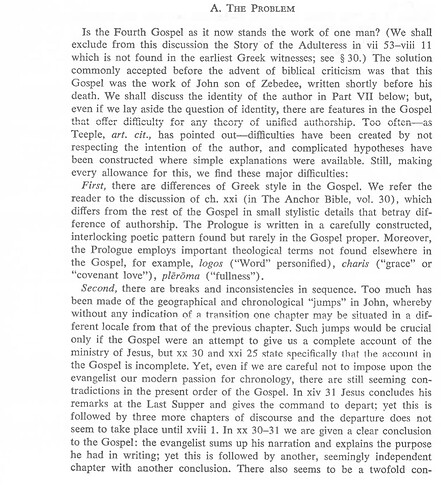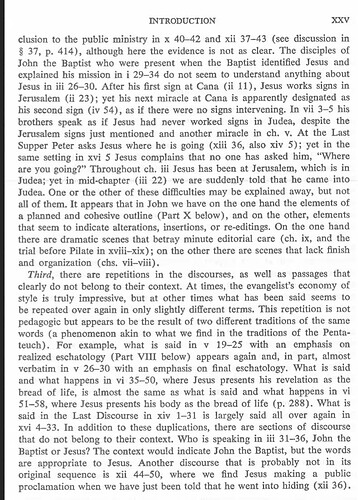We do not possess any original copies of the 27 written documents that constitute the New Testament or any of the Old Testament for that matter. What we do have for the New Testament is a lot of manuscript evidence (hand-written copies) and citations from Church fathers. There are many differences between the surviving manuscripts, admittedly most (not all) of these are inconsequential for major Christian doctrine. Because of this, many Christian apologists and conservative scholars often aver it was the original autographs of the New Testament that were inspired by God. It is believed that we can reconstruct them with a high degree of confidence.There are quite a few concerns with limiting the Inspiration of the Bible to the autographs, a term itself that is complicated
-
John clearly has two endings and was redacted (by a authoritative member of the community). The Prologue is also a later edition. It also looks like it is out of order in parts indicating a complex compositional history in the community. Which John was inspired? The original writing or the final redacted version that was canonized and might be out of order?
-
The canon edits itself. Matthew and Luke took the text of Mark and added a beginning and ending and a lot of content in addition to making subtle changes that sometimes soften Mark or even change the meaning. lf, if we accept the existence of Q and the independence of Matthew and Luke, the most common solution to the synoptic problem, there are a number of “agreements” in the extant texts of Matthew and Luke over and against the extant text of Mark, indicating they may have used a slightly different version. 2 Peter has allows swallowed up the text of Jude. But what Mark morphed into in Matthew and Luke in short order is certainly textually vexing. How do we identify an autograph for Mark?
-
2 Corinthians is most likely a composite of 2 or more letters of Paul edited together. it appears out of order, the tone shifts after chapter 9 and Titus is described as not in Corinth and working there a few chapters later. Were only Paul’s original epistles inspired or was the later author who merged and edited multiple letters together also inspired? What does an autograph even mean here? What is the autographical text here?
-
Multiple composition histories are posited for Isaiah but the most common is three authors. Isaiah and then two more tacking on sequentially after him (1-39, 40-55, 56-66). The notion of a singular autograph for a text that may have had multiple authors over hundreds of years and possibly an editor is somewhat problematic. Can we even presume each version of Isaiah would have been completely stable on textual grounds in the interim between the next recension?
-
Mosaic authorship of the Pentateuch is dead as can be. It was composed by multiple authors over long periods of time and edited together. Multiple creation stories, multiple flood accounts, a bunch of doublets and lots of different authors with tensions in the text. What does it even mean to claim the autographical text was inspired here? The final redactor?
-
There is some evidence Acts may have circulated in two versions. The Western text is almost 10% longer and a good suggestion is Luke published multiple versions. Many scholars also think Luke 3:1 is a formal beginning and that the infancy narrative was added in a later edition. His first version would have started similarly to Mark’s whom he was literarily dependent on. If Luke published multiple versions of his own work, or published his works over time, possibly updating things as new research came in, what on earth is an autograph and how could we ever detect it?
-
Is the Septuagint Inspired or the Hebrew Autographs?
New Testament authors frequently quoted the Old Testament through the Septuagint, the Greek translation of the Old Testament rather than the extant Hebrew Bible itself–let alone its autographs that are now lost. A problem surfaces in that the point made in a few of these passages appears to rely on a mistranslation of the Hebrew original! Is the Hebrew autograph inspired or the Greek mistranslation? Both? Did God inspire the original Hebrew autograph and then inspire an author to utilize a mistranslation of it in the NT? Why is the NT not using the Hebrew “autograph” if that is the inspired version?
It may certainly be true that some of the above viewpoints are not entirely correct but rejecting them all would only reek of uncritical harmonization and confirmation bias as they are all fairly standard in critical scholarship today.
There is evidence that New Testament works, including the Gospels were living documents in the first and second centuries. The thousands of variants in the surviving manuscripts demonstrate this. Two separate endings for Mark can be traced to the second century, as a specific example. But at least the changes we can know about in the manuscript record have a silver lining. They occurred late enough to be filtered out! All of the above redactions and issues cited under bold headings, if true, would more or less have occurred before the manuscript record–meaning these changes are so early our textual repositories cannot even detect them. We have a lot of manuscript evidence but there is a dark period of 100 or more years where the truth is, we have no real evidence for what these texts were exactly like. The above examples are textually humbling!
We also know that in the early second century Papias at least preferred oral tradition to written sources. D. C. Parker wrote:
Papias, early in the century, is actually cited by Eusebius as preferring oral to written traditions about Jesus: ‘I supposed that things out of books did not profit me so much as the utterances of a voice which liveth and abideth.’ In such a context, it is unlikely that written texts can have been free from alterations or additions from trusted oral sources. For example, may not a saying received at one remove from an eye-witness have been more highly estimated than the version of Luke, whose authorities were, as he himself confesses, other written accounts? [The Living Text of the Gospels pg 203-204]
Judging by modern standards, many Christians played fast and loose with the Old Testament, including the New Testament authors themselves at times. Why would we not expect Christian authors and preachers to do the same with the New Testament Gospels and Epistles which were not yet even afforded the full status of sacred scripture? We already have two examples of what a text like Mark could turn into within a few decades. It might be my imagination but for each book of the Bible I get the impression that some Christians envision a single author set out, sat down and wrote down whatever God told him to in some sort of “one and done” approach to inspiration. This would be the “autographical” text that many would deem inerrant and infallible. The textual record and careful study of the texts themselves does not lend itself to such a simplistic view. Of course, the redaction of our Biblical works or compilations of smaller sections of them do not need to be attributed to deficient or imperfect authorship. God may have composed what he did in stages for the benefit of the individual persons and communities who first received these works – or for whatever reason he deemed appropriate. After all, the Holy Spirit was present and Jesus was alive and well (he was resurrected if you missed it). Christian prophets were receiving proclamations and commands from the Lord and the Church was growing and learning. Correct doctrine and the Orthodox view were still being hashed out and would be for hundreds of years as was the issue of what sources should be accepted as authoritative and which ones heretical. Before a text becomes popular enough and authoritative, full-fledged scripture it will be the most fluid and susceptible to editing. We must always remember that while we believe the Bible was written for us in its final canonized form, none of it was written to us and this process took time. A continued and softer process of inspiration over a “one and done” autographical approach might be preferable given the nature of many Biblical works.
So for those who subscribe to the notion of autographs that are inspired, what exactly is an autograph? Are there other models of inspiration that are more of an ongoing process?
Vinnie

